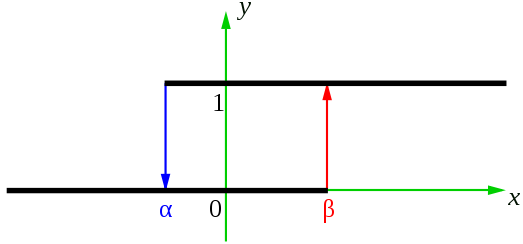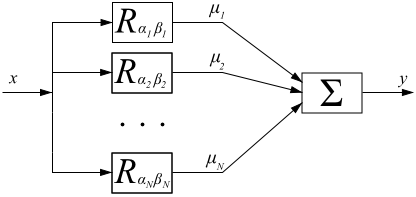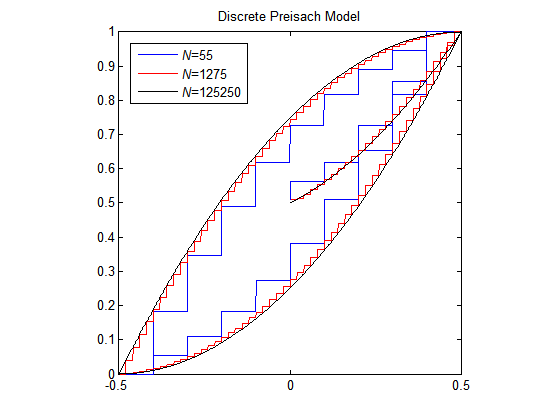
Preisach model of hysteresis
Encyclopedia
The Preisach model of hysteresis generalizes hysteresis
loops as the parallel connection of independent relay hysterons. It was first suggested in 1935 by Ferenc (Franz) Preisach in the German academic journal "Zeitschrift für Physik". Since then, it has become a widely accepted model of hysteresis. The Preisach model is especially accurate in the field of ferromagnetism
, as the ferromagnetic material can be described as a collection of small domains, each magnetized to a value of either or
or  . A sample of iron, for example, may have randomly distributed magnetic domains, resulting in a net magnetic field of zero.
. A sample of iron, for example, may have randomly distributed magnetic domains, resulting in a net magnetic field of zero.
 . Its I/O map takes the form of a loop, as shown:
. Its I/O map takes the form of a loop, as shown:

Above, a relay of magnitude 1. defines the "switch-off" threshold, and
defines the "switch-off" threshold, and  defines the "switch-on" threshold.
defines the "switch-on" threshold.
Graphically, if is less than
is less than  , the output
, the output  is "low" or "off." As we increase
is "low" or "off." As we increase  , the output remains low until
, the output remains low until  reaches
reaches  --at which point the output switches "on." Further increasing
--at which point the output switches "on." Further increasing  has no change. Decreasing
has no change. Decreasing  ,
,  does not go low until
does not go low until  reaches
reaches  again. It is apparent that the relay operator
again. It is apparent that the relay operator  takes the path of a loop, and its next state depends on its past state.
takes the path of a loop, and its next state depends on its past state.
Mathematically, the output of is expressed as:
is expressed as:

Where if the last time
if the last time  was outside of the boundaries
was outside of the boundaries  , it was in the region of
, it was in the region of  ; and
; and  if the last time
if the last time  was outside of the boundaries
was outside of the boundaries  , it was in the region of
, it was in the region of  .
.
This definition of the hysteron shows that the current value of the complete hysteresis loop depends upon the history of the input variable
of the complete hysteresis loop depends upon the history of the input variable  .
.

Each of these relays has different and
and  thresholds and is scaled by
thresholds and is scaled by  . Each relay can be plotted on a so-called Preisach plane with its
. Each relay can be plotted on a so-called Preisach plane with its  values. Depending on their distribution on the Preisach plane, the relay hysterons can represent hysteresis with good accuracy. As well, with increasing
values. Depending on their distribution on the Preisach plane, the relay hysterons can represent hysteresis with good accuracy. As well, with increasing  , the true hysteresis curve is approximated better.
, the true hysteresis curve is approximated better.

In the limit as approaches infinity, we obtain the continuous Preisach model.
approaches infinity, we obtain the continuous Preisach model.
The
One of the easiest ways to look at the preisach model is using a geometric interpretation.
Consider a plane of coordinates . On this plane, each point
. On this plane, each point  is mapped to a specific relay hysteron
is mapped to a specific relay hysteron  .
.
We consider only the half-plane as any other case does not have a physical equivalent in nature.
as any other case does not have a physical equivalent in nature.
Next, we take a specific point on the half plane and build a right triangle by drawing two lines parallel to the axes, both from the point to the line .
.
We now present the Preisach density function, denoted . This function describes the amount of relay hysterons of each distinct values of
. This function describes the amount of relay hysterons of each distinct values of  . As a default we say that outside the right triangle
. As a default we say that outside the right triangle  .
.
Hysteresis
Hysteresis is the dependence of a system not just on its current environment but also on its past. This dependence arises because the system can be in more than one internal state. To predict its future evolution, either its internal state or its history must be known. If a given input alternately...
loops as the parallel connection of independent relay hysterons. It was first suggested in 1935 by Ferenc (Franz) Preisach in the German academic journal "Zeitschrift für Physik". Since then, it has become a widely accepted model of hysteresis. The Preisach model is especially accurate in the field of ferromagnetism
Ferromagnetism
Ferromagnetism is the basic mechanism by which certain materials form permanent magnets, or are attracted to magnets. In physics, several different types of magnetism are distinguished...
, as the ferromagnetic material can be described as a collection of small domains, each magnetized to a value of either
 or
or  . A sample of iron, for example, may have randomly distributed magnetic domains, resulting in a net magnetic field of zero.
. A sample of iron, for example, may have randomly distributed magnetic domains, resulting in a net magnetic field of zero.Nonideal relay
The relay hysteron is the fundamental building block of the Preisach model. It is described as a two-valued operator denoted by . Its I/O map takes the form of a loop, as shown:
. Its I/O map takes the form of a loop, as shown:
Above, a relay of magnitude 1.
 defines the "switch-off" threshold, and
defines the "switch-off" threshold, and  defines the "switch-on" threshold.
defines the "switch-on" threshold.Graphically, if
 is less than
is less than  , the output
, the output  is "low" or "off." As we increase
is "low" or "off." As we increase  , the output remains low until
, the output remains low until  reaches
reaches  --at which point the output switches "on." Further increasing
--at which point the output switches "on." Further increasing  has no change. Decreasing
has no change. Decreasing  ,
,  does not go low until
does not go low until  reaches
reaches  again. It is apparent that the relay operator
again. It is apparent that the relay operator  takes the path of a loop, and its next state depends on its past state.
takes the path of a loop, and its next state depends on its past state.Mathematically, the output of
 is expressed as:
is expressed as:
Where
 if the last time
if the last time  was outside of the boundaries
was outside of the boundaries  , it was in the region of
, it was in the region of  ; and
; and  if the last time
if the last time  was outside of the boundaries
was outside of the boundaries  , it was in the region of
, it was in the region of  .
.This definition of the hysteron shows that the current value
 of the complete hysteresis loop depends upon the history of the input variable
of the complete hysteresis loop depends upon the history of the input variable  .
.Discrete Preisach model
The Preisach Model consists of many relay hysterons connected in parallel, given weights, and summed. This is best visualized by a block diagram:
Each of these relays has different
 and
and  thresholds and is scaled by
thresholds and is scaled by  . Each relay can be plotted on a so-called Preisach plane with its
. Each relay can be plotted on a so-called Preisach plane with its  values. Depending on their distribution on the Preisach plane, the relay hysterons can represent hysteresis with good accuracy. As well, with increasing
values. Depending on their distribution on the Preisach plane, the relay hysterons can represent hysteresis with good accuracy. As well, with increasing  , the true hysteresis curve is approximated better.
, the true hysteresis curve is approximated better.
In the limit as
 approaches infinity, we obtain the continuous Preisach model.
approaches infinity, we obtain the continuous Preisach model.The  plane
plane
One of the easiest ways to look at the preisach model is using a geometric interpretation.Consider a plane of coordinates
 . On this plane, each point
. On this plane, each point  is mapped to a specific relay hysteron
is mapped to a specific relay hysteron  .
.We consider only the half-plane
 as any other case does not have a physical equivalent in nature.
as any other case does not have a physical equivalent in nature.Next, we take a specific point on the half plane and build a right triangle by drawing two lines parallel to the axes, both from the point to the line
 .
.We now present the Preisach density function, denoted
 . This function describes the amount of relay hysterons of each distinct values of
. This function describes the amount of relay hysterons of each distinct values of  . As a default we say that outside the right triangle
. As a default we say that outside the right triangle  .
.

